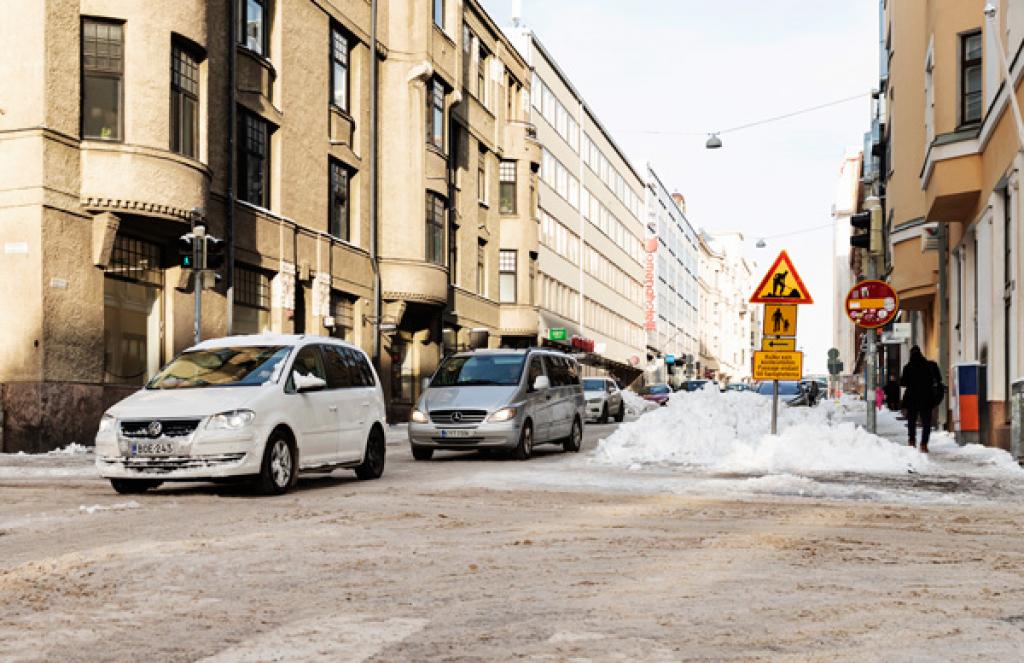Thessaloniki gets ready for its metro launch in November
The underground rapid transit lines have been under construction for almost two decades due to various project delays
 TheMayor.EU logo
TheMayor.EU logo 
Lönnrotinkatu street in Helsinki will be a test bed for the ban on studded tires, Source: Helsinki Municipality
Fine particles are the most challenging piece of the air quality puzzle for this Nordic capital
This winter, Helsinki’s authorities are urging drivers to opt for friction, rather than studded, car tires. The reason has nothing to do with improved safety or economic considerations. Instead, the argument goes that friction tires are simply better for the environment as they cause fewer dust particles and less noise.
Apart from the informational campaign, there will be a parallel pilot project starting this autumn which will completely ban the use of studded tires on one Helsinki street for the next three years. The street in question is Lönnrotinkatu in Kamppi.
Helsinki is by all accounts a champion city when it comes to air quality performance in the past 30 years. Nevertheless, one problem has really shown to be persistent despite all efforts – the concentration of fine dust particles in the city’s atmosphere.
Studies have shown that the main culprit behind the generation of this pollutant is the local motorized traffic and more specifically, the studded car tires which are preferred by drivers during the winter. Up to 40-50% of the street dust was generated by these tires since they create a sturdier impact on the road surfaces.
Today, the share of studded tires in Helsinki is about 70%. The goal set in Helsinki's air protection plan is to reduce the share of studded tires to 30% and increase the share of friction tires to 70% by the winter season 2030−2031.
The popularity of these tires stems from the impression that they provide better control and safety for winter driving.
However, research done in Stockholm and Oslo has shown that increased use in friction tires does not lead to more accidents. What’s more, the grip properties of studded tires are better on ice, whereas the grip properties of friction tires are better on snow. In Helsinki, however, severe ice is much rarer than in the rest of the country, and road surface freezing is prevented by anti-slippery methods based on salting. Thus, driving style affects safety more than tire type.

The underground rapid transit lines have been under construction for almost two decades due to various project delays

Now you can get your wine in Talence by paying directly in Bitcoin

That’s because the state has to spend money on updating the railway infrastructure rather than subsidizing the cost of the popular pass

Rethinking renewable energy sources for the urban landscape

The examples, compiled by Beyond Fossil Fuels, can inform and inspire communities and entrepreneurs that still feel trepidation at the prospect of energy transition

Now you can get your wine in Talence by paying directly in Bitcoin

The 10th European Conference on Sustainable Cities and Towns (ESCT) sets the stage for stronger cooperation between the EU, national and local level to fast track Europe's transition to climate neutrality.

At least, that’s the promise made by the mayor of Paris, Anne Hidalgo

The underground rapid transit lines have been under construction for almost two decades due to various project delays

At least, that’s the promise made by the mayor of Paris, Anne Hidalgo

Hostal de Pinós is located in the geographical centre of the autonomous region

Despite its church-y name, the district has long been known as the hangout spot for the artsy crowds

Urban dwellers across the EU are having a say in making their surroundings friendlier to people and the environment.

Forests in the EU can help green the European construction industry and bolster a continent-wide push for architectural improvements.

Apply by 10 November and do your part for the transformation of European public spaces

An interview with the Mayor of a Polish city that seeks to reinvent itself

An interview with the newly elected ICLEI President and Mayor of Malmö

A conversation with the Mayor of Lisbon about the spirit and dimensions of innovation present in the Portuguese capital














